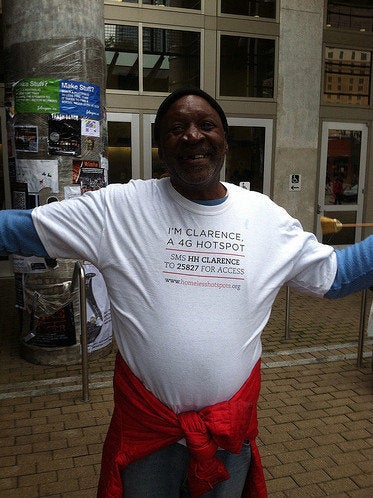
We've all been panhandled by a homeless person on street begging for money. I bet every one of you reading this has even been aggressively panhandled. It's awkward to be walking with your friends on a nice summer night just to have a homeless person rush you for money. Or maybe the light just turned red and you didn't make it through the intersection. Right in front of your car is a homeless person "flying a sign". You try not to make eye contact but the homeless man walks up to your window so you start praying the light turns green. Unfortunately, that's how the general public interacts with homelessness. The experience is always uncomfortable and often nasty, and it reinforces wrong stereotypes about our homeless neighbors.
That's why I like the street paper model and believe every community should have a street paper. I didn't at first. Street papers can sometimes be billed as a way for a homeless person to get off the streets. I always thought that was farfetched. I mean, street paper vendor's, after paying for the papers to sell, cannot make a living wage. But then it hit me. I saw the true benefit. Street papers provide a positive interaction between a homeless vendor and the general public.
The creative team at BBH Labs wanted to do something a little different at this year's SXSW. Something that would not only help the city of Austin but give back to a mostly forgotten group of people. They partnered with the local homeless shelter, built a neat little webpage, bought a few Mifis with service, and then empowered a few homeless folks to sell "pay what you wish" WiFi service around downtown Austin. The Homeless Hotspot webpage that BBH created (at their own expense) helps tell the each homeless vendors story and provides a way for people to donate directly to the homeless vendor! That's right. 100 percent of the money goes directly to the vendor. Like that's not enough, BBH also made a sizable donation to Front Steps.
When I first heard about the "Homeless Hotspots" I freaked out in the good way. I think the idea is brilliant, and it's a new idea in a nonprofit sector that is void of any new ideas, especially in tech. I am a realist so I immediately thought of a few flaws like how could this be scaled, and that people won't stand around on a sidewalk to get WiFi. But what really got me excited is WHAT ELSE COULD WE DO? Seriously, I don't see homeless hotspots as any kind of solution, but it may be the catalyst to an idea that will be a solution. What I mean by that is for a very long time all we have had is street papers. I know some places like Dignity Village in Portland (a city sanctioned tent community) has hotdog and espresso carts, and my friend Alan Graham just launched Street Treats in Austin, but what could we do with technology to create a positive interaction with homeless friends and the general public.
Check out my video interview with a 'Homeless Hotspot' and one of the creators. Then keep reading below:
In today's world we have refrigerators that can check our Twitter and Facebook status. Tech is changing everything we do and tech itself is changing faster and faster. But not in homeless services! Think about it, you can book a vacant hotel room from any computer with online access in the world, yet a homeless mom cannot find a shelter that does not have a waiting list. Homeless families and homeless people get turned away from shelter after shelter until they finally give up. The homeless services system is like out of the dark ages so no wonder people cannot find the help they need. Technology can change that. It has for you and me, but not homeless people. Although I don't see Homeless Hotspots getting adopted by homeless services, I sure hope it kicks a few people in the ass so they start thinking about how technology can help us save lives and money.
What happened with online media the last 12 hours is disgusting. New York Times, Read Write Web, Wired, and many others grabbed on to some negative spin without doing any real research. I believe it was conscious since everyone knows SXSW is the biggest dog and pony show of the year and controversy drives traffic. I won't link to the posts because they already have more than enough traffic by being irresponsible. They're not getting any from me. It was just stupid drama. People were even complaining about choice of verbs written on the shirts. I will give some props to Jon Mitchell who wrote the Read Write Web post. After a healthy conversation on twitter he updated the post with the "other" side of the story, and today I see he kept his word and went and interviewed a "hotspot vendor"! I know blogging isn't journalism but truth is better than spin. Can we please stop creating drama for traffic?!!
If you have never been to SXSW it's like a giant circus of gimmicks. It seems like big brands and marketing/PR firms all try and outdo each other. It's common to see people in strange outfits handing out handbills throughout downtown Austin. Much of it is way over the top. For the last three years I have been honored by an invite to speak, and in all of those three years I have never seen any SXSW campaign give back to the city of Austin. Not one! Instead of criticizing the one agency that at least tried to help we should be putting pressure on all the others that spent huge amounts of money and gave nothing back!
Point blank honest here: I strongly believe we can change the world tomorrow by being socially conscious about what we buy today. We have all the power to change the world in what we purchase. Big brands can help end homelessness, but controversy like what's happening with Homeless Hotspots scares the heck out of executives. In addition, homeless services needs help. We need fresh and creative ideas to help save lives and save money. Any brand, marketing agency, or Girl Scout Troupe that takes real tangible action to help solve a social crisis should be rewarded not slammed. What BBH Labs did with Homeless Hotspots is a harmless and fun idea that provides a positive interaction between homeless people and the rest of you. Plus, our homeless friends made a few bucks. And even more important -- they were given self-worth. Unless you are on the streets you have no idea how low someone's self-esteem can get. The number one thing you can give another person is your attention and the Homeless Hotspot vendors at SXSW got lots of that. Every one I met was smiling ear to ear.
The controversy that started right after a week of Invisible Children madness has me wondering if social media has turned us into whiny complainers. Everyone who complained has no connection to homeless services. Heck, the title of this post came from a homeless mom I was explaining the hotspots to and she said "sure beats panhandling"! Seriously, don't we all have much better things to do than complain about the words on a shirt? Of course I get it. Like I wrote earlier controversy drives traffic, and what happened the last 12 hours was really a bunch of interactive geeks having a spit fight to get attention.
We have enough drama and negativity in this world. Instead of criticizing those that are doing good, go out and do good yourself. Besides, instead of slamming homeless hotspots for trying to do good we all should be criticizing that no one in this presidential election has even mentioned homelessness!
